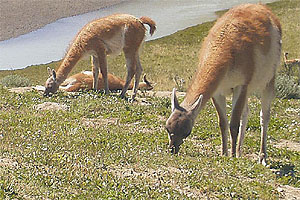The water scarcity, the great solar radiation and sharp thermal amplitude determine the kind of vegetation existing in this region. As a fact, there are species specifically adapted to bear the dessert dryness.
The vegetation, at its time, determines the kina of fauna Developer in this territory, which is characterized for being endemic and for the abundancr of camelia species.
In this region four flora and fauna zones are acknowledged and well differentiated. As follows, we shall describe then roughly.
– Coastal zone: in this are given more favorable characteristics for the development of vegetation, due to the oceanic influence. Predominating grass and pastures that grow in the periods of greater humidity, that is, in winter. Among the most representatives are liquens and various species of cactaceae (cactuses). There are also some bushes, such as chilca, (Nardophyllum lanatum), and in drier and sandier areas survive some graminae and salty pastures.
Among the fauna living in this sector we can find the Chungungo (Contra felina), the One-haired Sea Wolf (Otaria flavescens) and the culpeo Fox (Pseudolapex culpaeus). Among the birds are the Pelican (Pelecanus thagus) and the Dominican Sea-gull (Larus Dominicus).
– Coastal Ranges: in this relief develops xerofitic bush vegetation, cactuses and some grasses growing in winter and summer. Amongst the most abundant species of the first group is the Lechero, (Euphoorbia lactiflua), the Wild Manzanilla (Anthemis arvensis)and the Fox Tail (Sideritis angustifolia).
Amongst the cactacea stands out the Copao (Eulychnia breviflora), the Quisco (Echinopsis chilensis) and some kind of prickly pear. The most common herbs are the Wild Lettuce (Lactuca virosa), the Malvilla (Cristaria aspera) and the Vinagrillo (Oxalis arenaria)
– Pampa (intermediate depression) due to the absence of precipitations, to the extreme dryness and high temperatures, there is almost no vegetation in the pampa. However, the existing one adapts perfectly to this conditions, standing out some cactaceaus, herbs and bushes such as Sandillon de los Ratones (Eryiose redentgiophila), the Congonilla (Peperonia doellii), the candelabro Cactus (Browningia candelaris) and the Pata de Guanaco( Calandrinia longiscapa). The most common tree is the Tamarugo (Prosopis tamarugo).
Also the fauna is scarce and it can only be seen some birds such as the Saca tu real (Pyrocephalus rubinus) and the Paloma de Alas Blancas (asiatic Zenaida).
– Andean Steppe: in the high plateau zone, where predominates the height marginal dessertic climate, a denser type of vegetation is developed.
In this place grows the Llareta ( compact Azorella ), the Queñoa (Polylepis spp.), the Chastudo (Oreocereus leucotrichius), the Guacalla (Corryocactus brevistylus) and the Puscaya (bolivian Cumulopuntia)
The typical fauna from the high plateau is compounded mainly by camelids, Duch bas the llama (Llama glama), the Vicuña (Vicugna vicugna), the Alpaca (Vicuña pacos) and the Guanaco (Llama guanicoe).Other mammals living in the area are the Vizcacha (Lagidium viscacia), the Fox (Culpes culpes) and the Puna Quirquincho (Euphractus nationi). Also, can be seen some birds Duch as the Andean Flamingo or big Parina (Phoenicoparrus andinus), the small Parina (Phoenicoparrus jamesi), the chilean Flamingo (Phoenicoparrus chilensis), the Condor (Vultur gryphus), the giant Tagua (Fulica gigantea), the Andean Guallata or Piuquen (Choephaga melanoptera), the northern Cometocino (Prygilus atriceps), the Puna Duck (Anas puna), the puna Quail (Tinamotis pentlandii) and the Ñandú (Pterocnemi pennata).
Protected Zones
– The Lauca Nacional Park: located in the Putre community and includes the pre Andean ranges and the high plateau of this region extreme northeast.
It was created in 1965 as a national reservation to Project the flora and fauna, but, five years later it became in the cathegory of park.
It has a surface of 137.883 hectares and is between the 3.200 and 6.342 masl. Its main atractions are its volcanoes, some of which reach heights above the 6.000 masl. For example, the Parinacota (6.342 masl), the Pomerape (6.282 masl) and the Guallatire (6.060 masl).
Also are the Las Cuevas springs, the Cotacotani lagoons and the lake Chungara.
Its other great richness is the flora and fauna. In the pre Andean ranges area grows queñoa forests and in the high plateau, we can find vegetarian species Dutch as llaretas, the chastudos, the guacallas, the pajas bravas, the chilcas, among others,
Resides, in it inhabits almost the third part of the endemic chilean birds, among which we can find ñandúes, puna quails, condors, blanquillos and puna ducks and the juarjual. Also, there are abundant mammals Duch as vicuñas, the llamas, the guanacos, the vizcachas, foxes and pumas.
– Las Vicuñas Nacional Reserve: founded in 1983, is situated at 230 km from Arica in the putre community between the 4.300 and 5.600 masl. With a surface of 209.131 hectares, its climate is dry and characterized for its precipitations in summer (260mm annual rain) and snow in winter. The highest altitudes are the Puquintica (5.780masl) and the Aritinca hills (5.999 masl).
The vegetable species growing in this place are the pajonales, the queñoas, the tolares, the llaretas and the pajas.
The vicuña is the most representative animal in this reservation, therefrom its name. Though and also we can find alpacas, culpeo foxes, colocolo cats and some birds Duch as condors, swamp crows, ñandúes, puna quails and guallatas.








